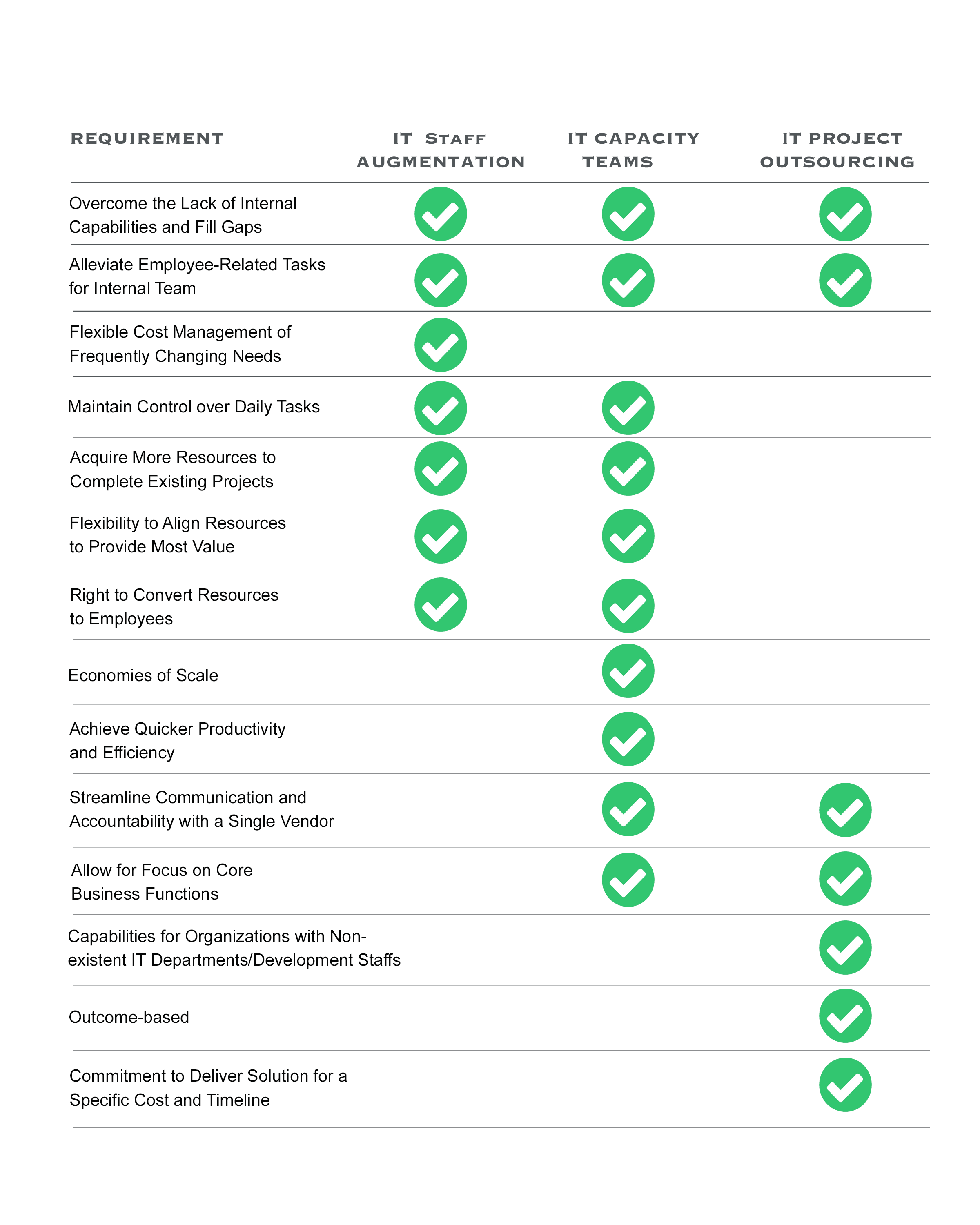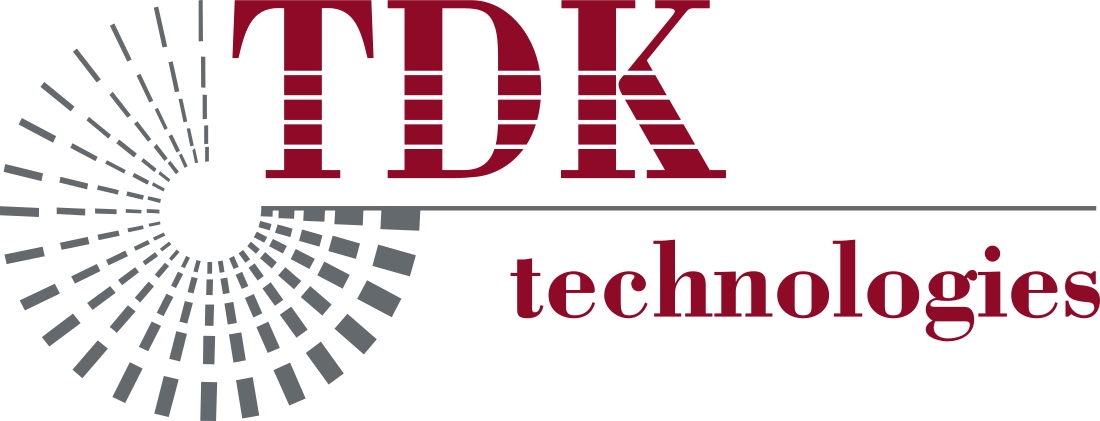Choosing the Right Delivery Model for Your Software Project
Around the globe, there’s an increasing drive for businesses to reduce costs and improve operational efficiencies through technological innovation.
Developing in-house capabilities to complete this growing number of IT projects can be costly and risky, particularly when the IT needs of an organization are constantly changing. This is where leveraging external resources becomes a compelling option.
When companies look for outside help to complete their IT projects, there are generally three delivery models to consider:
- Staff augmentation
- Capacity teams
- Project outsourcing
IT Staff Augmentation
IT staff augmentation allows a company to bolster a team with individual specialists based on the additional skills required to support their initiatives. They may be missing a particular skill on the team or need more of an existing skill.
Below, you’ll find some pros and cons to think about before deciding on the staff augmentation route.
Pros
- Control: Maintain control over daily tasks and resource management.
- Expertise: Obtain access to the specific skills needed for your project.
- Flexibility: Adapt to changing needs and project lifecycles.
- Scalability: Easily adjust resource allocation based on budget or project direction.
- Reduced Burden: Alleviate employee-related tasks for your internal team.
- Internal Acceptance: Easier for existing employees to understand the model and not feel their job is at risk.
- Right to hire: The option to convert resources to employees.
Cons
- Training: Training might be required depending on domain knowledge.
- Cost: May not benefit from economies of scale.
- Management: Increased responsibility to ensure resource performance.
- Employee vs. Contractor: Requires clear distinction in terms of co-employment.
- Multiple Vendors: Multiple consulting firms for individual resources can increase management complexity.
IT Capacity Teams
IT capacity teams allow a company to add a dedicated group of resources to their team. Options could include a full lifecycle software development team, multiple roles to augment an existing team, or a pool of resources aligned to a specific role/skillset.
Below, you’ll find some pros and cons to think about before deciding on the capacity team route.
Pros
- Synergy: Consulting firm resources have existing experience working together, leading to faster productivity and cost efficiency.
- Maintenance vs. Development: Capacity teams can handle either software maintenance/enhancements or new development while your employees focus on the work that best aligns to their interests and company strategies.
- Alignment: After experiencing the value of the capacity team, you can realign the resources to seed other internal teams.
- Single Vendor: Communication and accountability are streamlined with one consulting firm as a point of contact.
- Onboarding: The consulting firm provides training on your environment, systems, and architecture for immediate productivity.
- Economies of Scale: Benefit from economies of scale when utilizing a group of resources.
Cons
- Project Volume: The size of your project might not justify a group of resources.
- Accountability: Accountability for project outcomes can be challenging when integrating an external capacity team with your internal staff and resources from other vendors.
- Scalability: Not all consulting firms can quickly scale teams or resource pools based on fluctuating needs.
IT Project Outsourcing
IT project outsourcing allows a company to execute entire projects using the resources of a consulting firm. The consulting firm provides a deliverable-based solution where the tasks, resources, budget and timelines for the project are all managed by the consulting firm.
Below, you’ll find some pros and cons to think about before deciding on the project outsourcing route.
Pros
- Fills Gaps: This model is ideal if your company lacks the necessary resources, skills, or project management expertise.
- Outcome-Based: The consulting firm assumes the risk and commits to delivering the solution within a specific timeframe and budget.
- Clear Management: The consulting firm manages all project tasks and responsibilities.
- Right Sized: The consulting firm assigns the proper resources at the right time based on project needs.
- Cost Control: There is usually a "not-to-exceed" cost for achieving the desired outcome.
- Defined Timelines: Provides shorter timelines (1-3 months) with check-in points to evaluate engagement continuation.
- Defined Solution: The consulting firm clearly communicates and documents the solution approach.
- Focus on Core Business: Allows the organization to concentrate on central business functions.
Cons
- Clear Scope: Requires a well-defined project scope with detailed requirements.
- Reduced Control: Company has limited day-to-day control over project execution.
- Internal Resistance: Potential internal push-back to outsourcing work that may be perceived as job stability for existing employees.
- Vendor Selection: Critical to find a high-quality and reliable consulting firm.
- Scope Changes: Changes to the initial scope can impact timelines and costs.
- Resource Retention: Consulting firm resources used on the project typically cannot be converted to employees.
What’s the best delivery model for your business?
Choosing the right delivery model can be a complex decision. Many of the factors covered above may become part of a detailed cost benefit analysis.
There is no one-size-fits-all approach to success. For some companies, their needs are best met through staff augmentation, others through capacity teams, and others through project outsourcing. Sometimes these needs overlap.
Consider an example of two interdependent projects:
- The first project lies within a company's core competencies, but additional specialists are required to complete the project successfully.
- The second project lies outside of the company's core competencies altogether.
In this case, multiple delivery models may work best, where staff augmentation or a capacity team is used to acquire the required specialists for the first project, and project outsourcing is used to complete the second one.
While some companies feel comfortable making this decision internally, others may find it helpful to seek out the advice of an IT consulting firm. A consulting firm that supports staff augmentation, capacity teams, and project outsourcing can work with you to determine the best delivery model for your specific needs, whereas a firm that only supports a single delivery model may be inclined to recommend that delivery model regardless of whether it is the best option for your needs.
Below are some basic guidelines that can help navigate the decision-making process between staff augmentation, capacity teams, and project outsourcing.

To Recap
When selecting a vendor, consider working with one which provides multiple delivery models. This allows your business to utilize the best solution for a specific need, without the increased burden of managing multiple vendor relationships.
Find a vendor you can trust to take the time to understand your business and deliver the desired results, whether you need a single specialist, a group of specialists, or to outsource an entire project.
